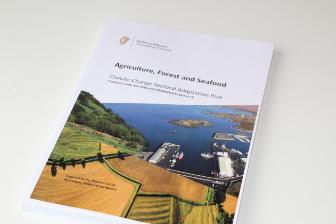Government approves Agriculture, Forest and Seafood Climate Adaptation Plan

The Adaptation Plan highlights a number of case studies identifying how the sector has, and will, continue to be impacted by changing weather patterns and steps towards building resilience.
6 November 2019
Minister for Agriculture, Michael Creed, welcomed government approval for the Agriculture, Forest and Seafood Climate Change Sectoral Adaptation Plan.
Adaptation is the process of preparing for the impacts of climate disruption, including for events such as flooding, fodder shortages, or extreme storm events.
“I am very pleased the Agriculture, Forest and Seafood Climate Change Sectoral Adaptation Plan has been approved as part of the whole-of-government approach adopted under Climate Action Plan 2019. We have taken a consistent approach to adaptation planning across the department and have prepared a single plan covering the agriculture, forest, and seafood sector.”, said Minister for Agriculture, Food and the Marine, Michael Creed.
Primary producers are very much to the forefront of dealing with the impacts of a changing climate but climate change is an issue which belongs to all of us; it is something that everyone in the production chain needs to consider. Nor is it solely a domestic issue.
Our agriculture, forest and seafood sectors will be impacted by global changes in climate also. The Minister went on to say that “in addition to reducing our emissions, we must ensure that our food production system is resilient and ready to adapt to future climate risk’’.
The Minister stated that “The Agriculture, Forest and Seafood Sectoral Adaptation Plan approved today is an important next step in our goal to build a strong and resilient sector that is well placed to take on the challenges and opportunities presented by our changing climate.”
The Adaptation Plan
The Adaptation Plan highlights a number of case studies identifying how the sector has and will continue to be impacted by changing weather patterns and steps towards building resilience.
The plan sets out the projected changes in climate, focussing on those identified as most likely to impact the agriculture, forest, and seafood sector. Priority risks and possible consequences have also been identified and listed.
The overarching objectives of the plan are to:
- Ensure a joined-up approach to adaptation planning in the Department of Agriculture, Food and the Marine (DAFM).
- Raise awareness of the impacts of climate change in the agriculture, forest, and seafood sector.
- Reduce vulnerability of the agriculture, forest, and seafood sector to main climate impacts and seek to increase resilience.
- Embed adaptation planning in agriculture, forest, and seafood sectoral policies.
The Horticulture Case Study
The Adaptation Plan in The Horticulture Case Study states that according to the Ensemble of regional climate model projections for Ireland report, the projected change for the period 2041-2060, will see an increase in the number of heavy rainfall events by approximately 20%, during the autumn and winter months.
The plan went onto use 2018, and the tough weather conditions faced by the trade that year as a key example of the impacts increased precipitation over the winter months can have on the trade.
“A projected increase in mean precipitation for winter was noted over most of Ireland for the high-emission scenario. The impact of such severe weather conditions was evident in 2018, with significantly delayed plantings in particular for outdoor vegetable crops and in some cases sowings/plantings being missed altogether because of wet soil conditions.
“Early vegetable crops that would have been sown or planted out in March were skipped; other
crops were planted out in less than favourable conditions, a situation made worse with the
subsequent drought due to initial poor establishment.
“The subsequent extreme warm weather had a dramatic effect on production costs where input costs increased substantially. Additional fuel and labour costs were required to irrigate growing crops in an attempt to maintain yield and quality and additional energy was required to chill crops post harvest and to maintain temperatures at acceptable levels within protected structures such as glasshouses and mushroom tunnels.
“Harvesting and labour costs increased where the extreme weather resulted in rapid ripening of crops and in cases adversely effecting crop quality where discoloration and bolting became an issue.
“This resulted in the need for rapid and regular harvesting of crops. Further, the warm and dry weather increased pest and disease pressure in crops and reduced the efficacy of available crop protection measures.
“Production in 2018 was impacted where expected yields were not attained for many crops, in particular for potatoes where yields were back by up 30% on previous year.”
Steps Towards Building Resilience
The plan identifies adaptation strategies that will address the vulnerability of the sector to increased temperature and drought. “Innovation and advances in crop breeding and plant genetics will be important; to include developing stress tolerant varieties that will help cope with increased temperatures and drought, in addition to better pest and disease resistance.”
The plan can be found here.



 Print
Print









Fans 0
Followers